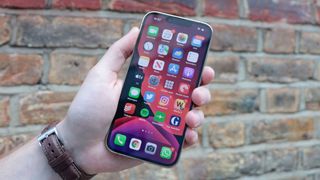iPhone 14 may take another step towards portless design by ditching mobile staple
Apple could be pushing for an eSIM-only future

We’ve been hearing for a while that eSIMs (embedded SIMs) might soon replace physical SIM cards, and it’s now sounding a lot like the iPhone 14 could be the phone that kicks off this transition, as some versions will reportedly be sold without a removable SIM card.
That’s according to The Wall Street Journal, and means a subset of 2022's iPhone family will potentially be solely reliant on an eSIM. Rather than popping a tray out of the side of the phone and slotting in a physical SIM card, an eSIM is a digital SIM that’s built into the phone and can't be removed; so when changing carriers/networks a new number is just programmed onto it, rather than needing to slot in a physical card.
However, this change is unlikely to be forced upon you if you buy an iPhone 14. Rather, eSIM-only variants of the iPhone 14, iPhone 14 Pro, iPhone 14 Pro Max, and iPhone 14 Max are expected to be offered alongside models that have both eSIM and a physical SIM card support.
It would then be down to telecom companies and stores to decide whether to stock the eSIM-only versions alongside the standard versions or not. It doesn’t sound like there’s an expectation that any carrier will just stock the eSIM-only versions, so you’re likely to have the choice, regardless of which mobile carrier you use.
This isn’t the first time we’ve heard a claim like this, and there are clear advantages in moving to eSIM-only handsets. They take up less room in phones, so that frees up space for larger batteries or other technology. eSIMs can also support multiple networks, so you can still have essentially a dual-SIM phone that only relies on eSIM technology.
Plus, changing network with an eSIM is theoretically a faster, slicker process than the method with physical SIM cards. And eSIMs can be patched more easily, with security updates sent out on a much larger scale than is possible with physical SIM cards.
So they probably are the future, and if any company is positioned to spur on their mass-adoption, it’s Apple.
Get daily insight, inspiration and deals in your inbox
Get the hottest deals available in your inbox plus news, reviews, opinion, analysis and more from the TechRadar team.
Analysis: there needs to be some motivation
Offering eSIM-only models of the iPhone 14 along with versions that have both an eSIM and a physical SIM makes sense in some ways. Apple has long-offered the latter with iPhones, so it’s clear the company is interested in eSIMs, and offering an eSIM-only version as a choice would help build the popularity of this newer technology, without forcing people to make a change.
Yet, it’s a step that might be too small too, unless it comes with other perks. If customers are offered the choice of a phone that only supports eSIM or one with a physical SIM slot too, why would they choose the former unless it’s also cheaper or has other immediate advantages?
In most cases, they probably wouldn’t. Apple is unlikely to capitalize on the space saving the eSIM-only devices permit when the model is just a variation of a phone that typically does have a physical SIM, and right now most of the other advantages eSIMs offer aren’t really being leveraged either, namely due to lacking carrier support.
So, although the introduction of an eSIM-only iPhone may help user adoption, on its own it doesn't feel as though it's set to make much of an impact. Hopefully, Apple will do more to incentivize people to embrace an eSIM-filled future, leading to a point where all the best phones are eSIM-only.
James is a freelance phones, tablets and wearables writer and sub-editor at TechRadar. He has a love for everything ‘smart’, from watches to lights, and can often be found arguing with AI assistants or drowning in the latest apps. James also contributes to 3G.co.uk, 4G.co.uk and 5G.co.uk and has written for T3, Digital Camera World, Clarity Media and others, with work on the web, in print and on TV.

